邹城市第一中学2018届高三上学期期中考试英语试题及答案
- 格式:docx
- 大小:31.32 KB
- 文档页数:12
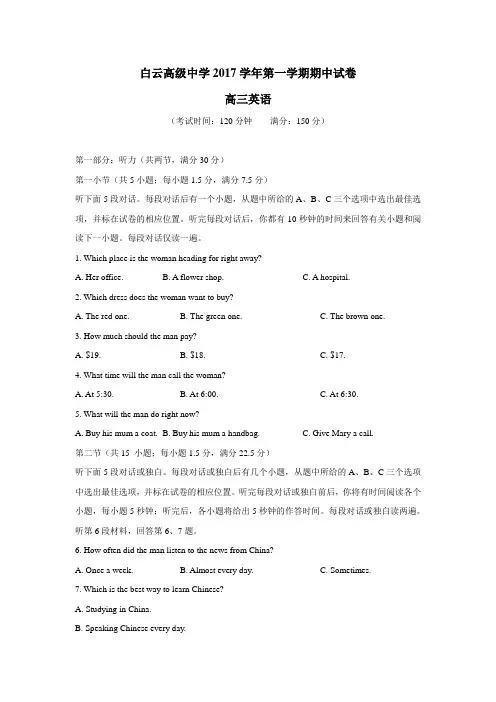
白云高级中学2017学年第一学期期中试卷高三英语(考试时间:120分钟满分:150分)第一部分:听力(共两节,满分30分)第一小节(共5小题;每小题1.5分,满分7.5分)听下面5段对话。
每段对话后有一个小题,从题中所给的A、B、C三个选项中选出最佳选项,并标在试卷的相应位置。
听完每段对话后,你都有10秒钟的时间来回答有关小题和阅读下一小题。
每段对话仅读一遍。
1. Which place is the woman heading for right away?A. Her office.B. A flower shop.C. A hospital.2. Which dress does the woman want to buy?A. The red one.B. The green one.C. The brown one.3. How much should the man pay?A. $19.B. $18.C. $17.4. What time will the man call the woman?A. At 5:30.B. At 6:00.C. At 6:30.5. What will the man do right now?A. Buy his mum a coat.B. Buy his mum a handbag.C. Give Mary a call.第二节(共15 小题;每小题1.5分,满分22.5分)听下面5段对话或独白。
每段对话或独白后有几个小题,从题中所给的A、B、C三个选项中选出最佳选项,并标在试卷的相应位置。
听完每段对话或独白前后,你将有时间阅读各个小题,每小题5秒钟;听完后,各小题将给出5秒钟的作答时间。
每段对话或独白读两遍。
听第6段材料,回答第6、7题。
6. How often did the man listen to the news from China?A. Once a week.B. Almost every day.C. Sometimes.7. Which is the best way to learn Chinese?A. Studying in China.B. Speaking Chinese every day.C. Listening to the news from China.听第7段材料,回答第8、9题。
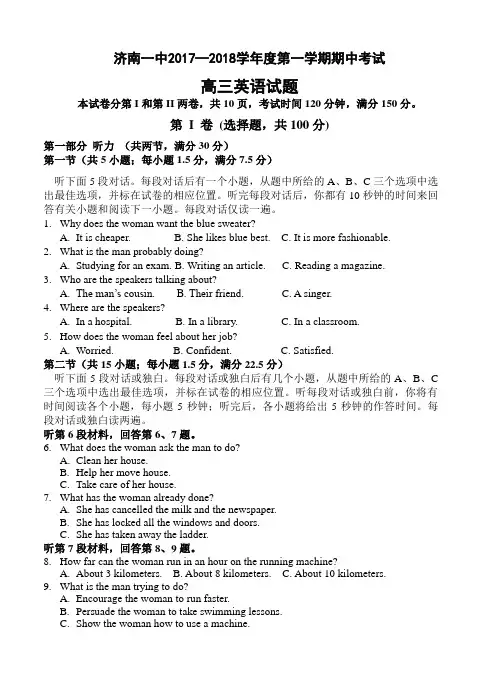
济南一中2017—2018学年度第一学期期中考试高三英语试题本试卷分第I和第II两卷,共10页,考试时间120分钟,满分150分。
第I 卷(选择题,共100分)第一部分听力(共两节,满分30分)第一节(共5小题;每小题1.5分,满分7.5分)听下面5段对话。
每段对话后有一个小题,从题中所给的A、B、C三个选项中选出最佳选项,并标在试卷的相应位置。
听完每段对话后,你都有10秒钟的时间来回答有关小题和阅读下一小题。
每段对话仅读一遍。
1.Why does the woman want the blue sweater?A.It is cheaper.B. She likes blue best.C. It is more fashionable.2.What is the man probably doing?A.Studying for an exam.B. Writing an article.C. Reading a magazine.3.Who are the speakers talking about?A.The man’s cousin.B. Their friend.C. A singer.4.Where are the speakers?A.In a hospital.B. In a library.C. In a classroom.5.How does the woman feel about her job?A.Worried.B. Confident.C. Satisfied.第二节(共15小题;每小题1.5分,满分22.5分)听下面5段对话或独白。
每段对话或独白后有几个小题,从题中所给的A、B、C 三个选项中选出最佳选项,并标在试卷的相应位置。
听每段对话或独白前,你将有时间阅读各个小题,每小题5秒钟;听完后,各小题将给出5秒钟的作答时间。
每段对话或独白读两遍。
听第6段材料,回答第6、7题。
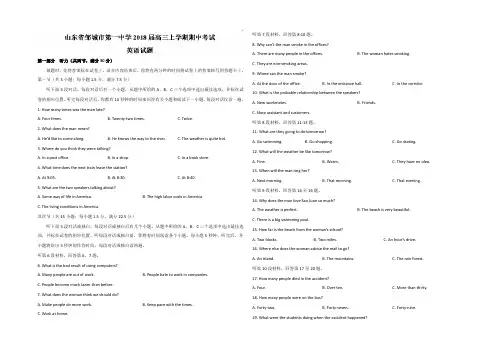
第一部分听力(共两节,满分30分)做题时,先将答案标在试卷上。
录音内容结束后,你将有两分钟的时间将试卷上的答案转写到答题卡上。
第一节(共5小题;每小题1.5分,满分7.5分)听下面5段对话。
每段对话后有一个小题,从题中所给的A、B、C三个选项中选出最佳选项,并标在试卷的相应位置。
听完每段对话后,你都有10秒钟的时间来回答有关小题和阅读下一小题。
每段对话仅读一遍。
1. How many times was the man late?A. Four times.B. Twenty-two times.C. Twice.2. What does the man mean?A. He’d like to come along.B. He knows the way to the river.C. The weather is quite hot.3. Where do you think they were talking?A. In a post office.B. In a shop.C. In a book store.4. What time does the next train leave the station?A. At 9:05.B. At 8:30.C. At 8:40.5. What are the two speakers talking about?A. Some way of life in America.B. The high labor costs in America.C. The living conditions in America.其次节(共15小题;每小题1.5分,满分22.5分)听下面5段对话或独白。
每段对话或独白后有几个小题,从题中所给的A、B、C三个选项中选出最佳选项,并标在试卷的相应位置。
听每段对话或独白前,你将有时间阅读各个小题,每小题5秒钟;听完后,各小题将给出5秒钟的作答时间。
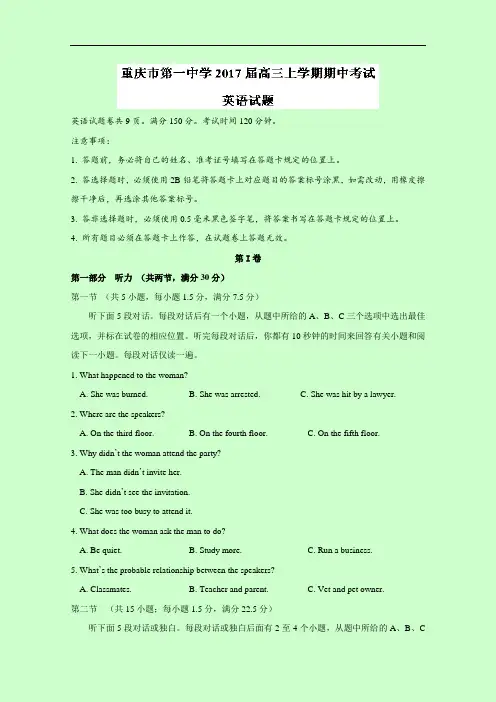
英语试题卷共9页。
满分150分。
考试时间120分钟。
注意事项:1. 答题前,务必将自己的姓名、准考证号填写在答题卡规定的位置上。
2. 答选择题时,必须使用2B铅笔将答题卡上对应题目的答案标号涂黑,如需改动,用橡皮擦擦干净后,再选涂其他答案标号。
3. 答非选择题时,必须使用0.5毫米黑色签字笔,将答案书写在答题卡规定的位置上。
4. 所有题目必须在答题卡上作答,在试题卷上答题无效。
第I卷第一部分听力(共两节,满分30分)第一节(共5小题,每小题1.5分,满分7.5分)听下面5段对话。
每段对话后有一个小题,从题中所给的A、B、C三个选项中选出最佳选项,并标在试卷的相应位置。
听完每段对话后,你都有10秒钟的时间来回答有关小题和阅读下一小题。
每段对话仅读一遍。
1. What happened to the woman?A. She was burned.B. She was arrested.C. She was hit by a lawyer.2. Where are the speakers?A. On the third floor.B. On the fourth floor.C. On the fifth floor.3. Why didn’t the woman attend the party?A. The man didn’t invite her.B. She didn’t see the invitation.C. She was too busy to attend it.4. What does the woman ask the man to do?A. Be quiet.B. Study more.C. Run a business.5. What’s the probable relationship between the speakers?A. Classmates.B. Teacher and parent.C. Vet and pet owner.第二节(共15小题;每小题1.5分,满分22.5分)听下面5段对话或独白。
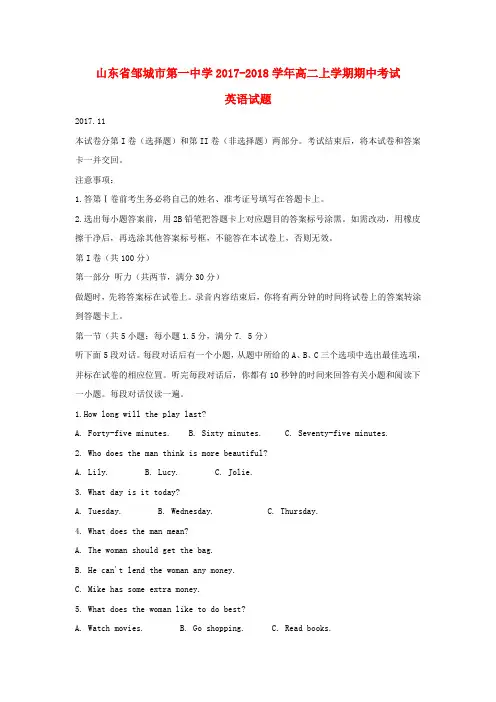
山东省邹城市第一中学2017-2018学年高二上学期期中考试英语试题2017.11本试卷分第I卷(选择题)和第II卷(非选择题)两部分。
考试结束后,将本试卷和答案卡一并交回。
注意事项:1.答第Ⅰ卷前考生务必将自己的姓名、准考证号填写在答题卡上。
2.选出每小题答案前,用2B铅笔把答题卡上对应题目的答案标号涂黑。
如需改动,用橡皮擦干净后,再选涂其他答案标号框,不能答在本试卷上,否则无效。
第I卷(共100分)第一部分听力(共两节,满分30分)做题时,先将答案标在试卷上。
录音内容结束后,你将有两分钟的时间将试卷上的答案转涂到答题卡上。
第一节(共5小题:每小题1.5分,满分7. 5分)听下面5段对话。
每段对话后有一个小题,从题中所给的A、B、C三个选项中选出最佳选项,并标在试卷的相应位罝。
听完毎段对话后,你都有10秒钟的时间来回答有关小题和阅读下一小题。
每段对话仅读一遍。
1.How long will the play last?A. Forty-five minutes.B. Sixty minutes.C. Seventy-five minutes.2. Who does the man think is more beautiful?A. Lily.B. Lucy.C. Jolie.3. What day is it today?A. Tuesday.B. Wednesday.C. Thursday.4. What does the man mean?A. The woman should get the bag.B. He can't lend the woman any money.C. Mike has some extra money.5. What does the woman like to do best?A. Watch movies.B. Go shopping.C. Read books.第二节(共15小题;每小题1.5分,满分22.5分)听下面5段对话或对白,每段对话或独白后有几个小题,从题中所给的A、B、C三个选项中选出最佳选项,并标在试卷的相应位置,听每段对话或独白前,你将有时间阅读各个小题。
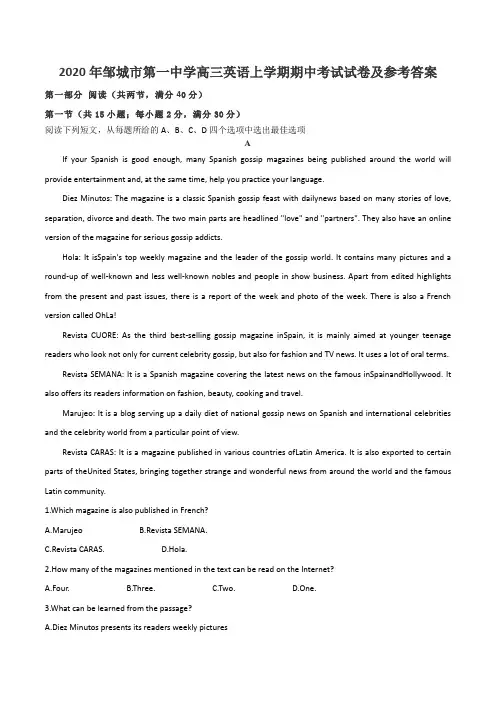
2020年邹城市第一中学高三英语上学期期中考试试卷及参考答案第一部分阅读(共两节,满分40分)第一节(共15小题;每小题2分,满分30分)阅读下列短文,从每题所给的A、B、C、D四个选项中选出最佳选项AIf your Spanish is good enough, many Spanish gossip magazines being published around the world will provide entertainment and, at the same time, help you practice your language.Diez Minutos: The magazine is a classic Spanish gossip feast with dailynews based on many stories of love, separation, divorce and death. The two main parts are headlined "love" and "partners". They also have an online version of the magazine for serious gossip addicts.Hola: It isSpain's top weekly magazine and the leader of the gossip world. It contains many pictures and a round-up of well-known and less well-known nobles and people in show business. Apart from edited highlights from the present and past issues, there is a report of the week and photo of the week. There is also a French version called OhLa!Revista CUORE: As the third best-selling gossip magazine inSpain, it is mainly aimed at younger teenage readers who look not only for current celebrity gossip, but also for fashion and TV news. It uses a lot of oral terms.Revista SEMANA: It is a Spanish magazine covering the latest news on the famous inSpainandHollywood. It also offers its readers information on fashion, beauty, cooking and travel.Marujeo: It is a blog serving up a daily diet of national gossip news on Spanish and international celebrities and the celebrity world from a particular point of view.Revista CARAS: It is a magazine published in various countries ofLatin America. It is also exported to certain parts of theUnited States, bringing together strange and wonderful news from around the world and the famous Latin community.1.Which magazine is also published in French?A.MarujeoB.Revista SEMANA.C.Revista CARAS.D.Hola.2.How many of the magazines mentioned in the text can be read on the Internet?A.Four.B.Three.C.Two.D.One.3.What can be learned from the passage?A.Diez Minutos presents its readers weekly picturesB.Revista CUORE can help improve one's spoken Spanish.C.Revista SEMANA is intended for readers in teensD.Revista CARAS mainly reports news fromLatin America.BWhy doesHaitiso tend to have fatal earthquakes? Earthquakes have been causing huge damage inHaitisince at least the 18th century. The capital city has been destroyed twice in 19 years. The 21st century has beenno more kind.The Earth’s outer shell is made tip of tectonic plates (构造板块) that move.Haitisits near the crossing of two tectonic plaits that make up the Earth’s outer shell. Earthquakes can occur when those plates move against each other and create friction (摩擦力).Haitiis also overpopulated. Plus, many of its buildings are designed to resist hurricanes but not earthquakes. Those buildings can survive strong winds bat are easy to fail down when the ground shrikes. Poor building practices can also play arole.“I think it’s important to recognize that there’s no such thing as a natural disaster,” said Wendy Bohon, a geologist. “What you have is a natural disaster that comes with a weak architecture system. We do know that earthquakes like this can cause huge damage because ofthefault,” said Wendy. “And it’s quite a significant risk in places that don’t have the construction practices to resist the shaking.”Construction of more earthquake-resistant buildings remains a challenge inHaiti, which is the poorest nation in theWestern Hemisphere. “While there have been some success stories of Haitians building more earthquake-resistant structures, the country has lacked a centralized effort to do so,” said Mark Schuller, a professor of anthropology and nonprofit and NGO studies atNorthernIllinoisUniversity.Haiti’s government has become increasingly weak, while non-governmental organizations only focus on their own projects.“There is technical knowledge inHaiti, There are trained architects. There are cityplanners. That’s not the problem,” Schuller said. “The problem is a lack of funding for coordination (协调), and lack of political will from donors to organizations providing aid.”4. Which factor causing the huge damage is highlighted?A. Its overpopulation.B. Its weak government.C. Its geographical location.D. Its weak architecture system.5. What does the underlined part “the fault” in paragraph 4 refer to?A Lacking political will to provide aid.B. Lacking hurricane-resistant; buildings.C. Lacking earthquake-resistant buildings.D. Sitting on the crossing of two tectonic plates.6. What’s Schuller’s attitude towardsHaiti’s government?A Supportive. B. Critical.C. Indifferent.D. Interested.7. Which of the following can be a problem according tothe last paragraph?A. Fund and will.B. Skilled architects.C. Urban designers.D. Technology and money.CJanet Fein, aged 84, received her bachelor's degree from the University last week, having waited a long time for her chance to reach that goal.Growing up in the Bronx area ofNew York City, Fein worked at a dress manufacturer after graduating early at the age of 16. After getting married, she spent 18 years staying home with her children. She held several jobs through her life, including 20 years as a secretary at a hospital until her retirement at age 77.Fein has had a full life. But even then, she was not ready to take it easy and rest during a well-earned retirement. She decided to major in sociology because she felt it was “substantial.”Fein took part in a state program that lets people who are 65 and older take free classes at public universities in Texasand kept going to class even as her health conditions worsened. During her studies, it became necessary for her to use a walker to get around and she required oxygen. She also developed knee problems. So, Fein took online classes to finish the last part of her degree requirements.Sheila Rollerson, Fein' scollege advisor, and Carol, the professor told the media that Fein never showed signs of giving up even with all of her difficulties. She would speak up a lot in class and it just made for a more interesting class.Fein has also inspired Renee Brown, one of Fein's caregivers. At 53, Renee plans to begin nursing school to further her career. “Renee, you can do it. If I can do it you can do it, and you will feel so good about it,” Brown remembers what Fein told her.8. What is the second paragraph mainly about?A. Janet Fein's growthB. Janet Fein's aimC. Janet Fein's job experiencesD. Janet Fein's regrets9. What does the underlined phrase “substantial” in paragraph 3 refer to?A. InterestingB. ValuableC. EasyD. Affordable10. What can be learned about Fein according to the passage?A. Fein lived on little money after her retirement.B. Fein had a problem with her arms while at universities.C. The Internet played a role in Fein's university education.D. The good health helped Fein get her bachelor's degree.11. What is Janet Fein like according to the passage?A. Hardworking and humorous.B. Determined and generous.C. Positive and patient.D. Inspiring and perseverant.DIdentifying the chemical makeup of pigment (色素) used in ancient documents, paintings, and watercolor1 s is criticalto restoring and conserving the precious artworks. However, despite numerous efforts, scientists had been unable to determine the source of folium, a popular blue dye used to color1 manuscripts (手稿) in Europe during the middle ages — from the 5th to the 15th century. Now, a team of researchers fromPortugalhas finally uncovered the mysterious ingredient responsible for the gorgeous blueish-purple color1 that helped bring ancient illustrations and texts to life.The research team began byporing overinstructions penned by European dye makers from the 12th, 14th, and 15th centuries. They found what they were seeking in a 15th-century text entitledThe Book on How to Make All the Color Paints for Illuminating Books. However, translating the instructions was no easy task. It was written in the now extinct Judaeo-Portuguese language, and though the source of the dye was traced back to a plant, no name was mentioned.However, by piecing together suggestions from the text, the scientists were able to determine that the dye was made from the bluish-green berries of the chrozophora tinctoria plant. After an extensive search, the team found a few varieties of the plant growing along the roadside near the town ofMonsarazin southPortugal.The detailed instructions gave the researchers critical clues — including the best time to pick the berries. “You need to squeeze the fruits, being careful not to break the seeds, and then to put them on linen (亚麻).” The scientist says the detail was important since broken seeds polluted the pigment, producing an inferior quality ink. The dyed linen, which was left to dry, was an efficient way to store and transport the pigment during ancient times.When needed, the artist would simply cut off a piece of the cloth and dip it with water to squeeze out the blue color1 .Once the key ingredient had been identified, the researchers began to determine the dye’s molecular structure. To their surprise, they found that folium was not like any other known permanent blue dyes — it was an entirely new class of color1 , one they named chrozophoridin. “Chrozophoridin was used in ancient times to make a beautiful blue dye for painting.” the team wrote in the study. “Thus, we believe that this will not be our final word on this amazing plant and its story and that further discoveries will follow soon.”12. The primary purpose of the study is to ________.A. restore and conserve ancient precious artworksB. determine the substance making up the foliumC. prove the ancient dye-making technique was organicD. identify which class of color1 folium belongs to13. The underlined phrase “poring over”in the second paragraph means ________.A. discussing publiclyB. testing repeatedlyC. passing directlyD. reading carefully14. What can be learned about the blue dye folium?A. It was essentially an inferior type of ink.B. It was the only kind made from wild berries.C. It could be carried and used easily.D. It was carefully squeezed from broken seeds.15. The article is mainly about _________.A. how the mystery ofa thousand-year-old blue dye was solvedB. why the researchers took the trouble to recreate the dyeC. what needs to be done to make an organic dye from a plantD. when and where the discovery of the dye was made第二节(共5小题;每小题2分,满分10分)阅读下面短文,从短文后的选项中选出可以填入空白处的最佳选项。
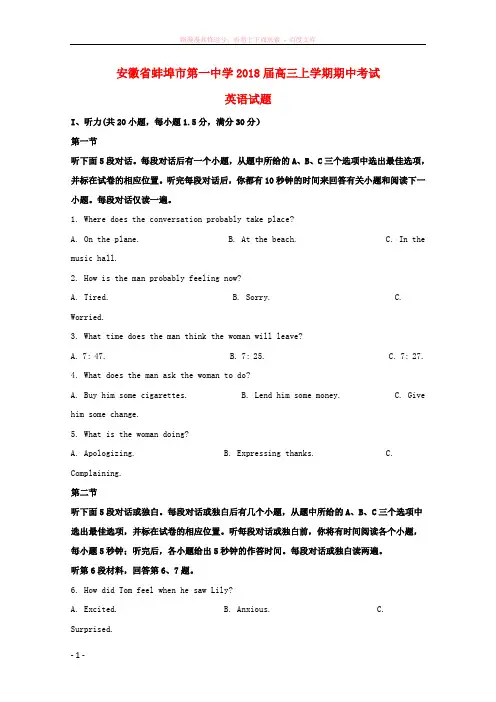
安徽省蚌埠市第一中学2018届高三上学期期中考试英语试题I、听力(共20小题,每小题1.5分,满分30分)第一节听下面5段对话。
每段对话后有一个小题,从题中所给的A、B、C三个选项中选出最佳选项,并标在试卷的相应位置。
听完每段对话后,你都有10秒钟的时间来回答有关小题和阅读下一小题。
每段对话仅读一遍。
1. Where does the conversation probably take place?A. On the plane.B. At the beach.C. In the music hall.2. How is the man probably feeling now?A. Tired.B. Sorry.C. Worried.3. What time does the man think the woman will leave?A. 7: 47.B. 7: 25.C. 7: 27.4. What does the man ask the woman to do?A. Buy him some cigarettes.B. Lend him some money.C. Give him some change.5. What is the woman doing?A. Apologizing.B. Expressing thanks.C. Complaining.第二节听下面5段对话或独白。
每段对话或独白后有几个小题,从题中所给的A、B、C三个选项中选出最佳选项,并标在试卷的相应位置。
听每段对话或独白前,你将有时间阅读各个小题,每小题5秒钟;听完后,各小题给出5秒钟的作答时间。
每段对话或独白读两遍。
听第6段材料,回答第6、7题。
6. How did Tom feel when he saw Lily?A. Excited.B. Anxious.C. Surprised.7. What is the whole class talking about?A. How Lily got fired.B. Where Lily got married.C. Why Lily changed her name.听第7段材料,回答第8、9题。
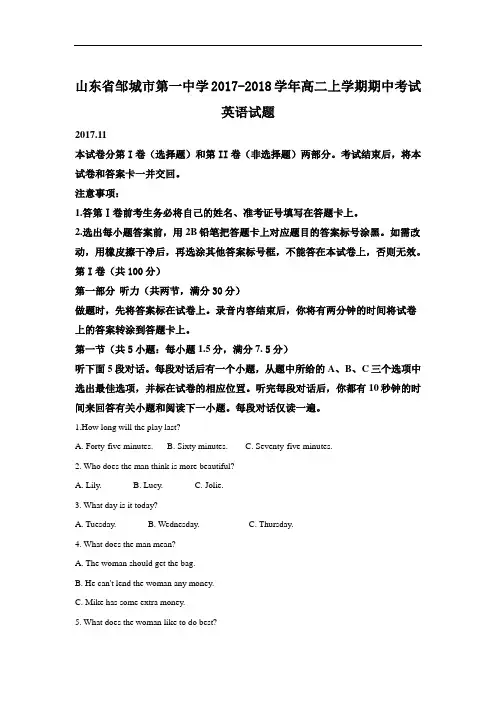
山东省邹城市第一中学2017-2018学年高二上学期期中考试英语试题2017.11本试卷分第I卷(选择题)和第II卷(非选择题)两部分。
考试结束后,将本试卷和答案卡一并交回。
注意事项:1.答第Ⅰ卷前考生务必将自己的姓名、准考证号填写在答题卡上。
2.选出每小题答案前,用2B铅笔把答题卡上对应题目的答案标号涂黑。
如需改动,用橡皮擦干净后,再选涂其他答案标号框,不能答在本试卷上,否则无效。
第I卷(共100分)第一部分听力(共两节,满分30分)做题时,先将答案标在试卷上。
录音内容结束后,你将有两分钟的时间将试卷上的答案转涂到答题卡上。
第一节(共5小题:每小题1.5分,满分7. 5分)听下面5段对话。
每段对话后有一个小题,从题中所给的A、B、C三个选项中选出最佳选项,并标在试卷的相应位罝。
听完毎段对话后,你都有10秒钟的时间来回答有关小题和阅读下一小题。
每段对话仅读一遍。
1.How long will the play last?A. Forty-five minutes.B. Sixty minutes.C. Seventy-five minutes.2. Who does the man think is more beautiful?A. Lily.B. Lucy.C. Jolie.3. What day is it today?A. Tuesday.B. Wednesday.C. Thursday.4. What does the man mean?A. The woman should get the bag.B. He can't lend the woman any money.C. Mike has some extra money.5. What does the woman like to do best?A. Watch movies.B. Go shopping.C. Read books.第二节(共15小题;每小题1.5分,满分22.5分)听下面5段对话或对白,每段对话或独白后有几个小题,从题中所给的A、B、C 三个选项中选出最佳选项,并标在试卷的相应位置,听每段对话或独白前,你将有时间阅读各个小题。
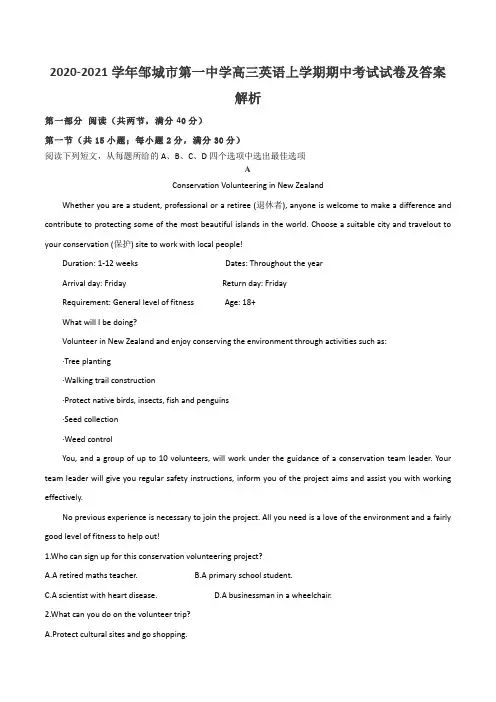
2020-2021学年邹城市第一中学高三英语上学期期中考试试卷及答案解析第一部分阅读(共两节,满分40分)第一节(共15小题;每小题2分,满分30分)阅读下列短文,从每题所给的A、B、C、D四个选项中选出最佳选项AConservation Volunteering in New ZealandWhether you are a student, professional or a retiree (退休者), anyone is welcome to make a difference and contribute to protecting some of the most beautiful islands in the world. Choose a suitable city and travelout to your conservation (保护) site to work with local people!Duration: 1-12 weeks Dates: Throughout the yearArrival day: Friday Return day: FridayRequirement: General level of fitness Age: 18+What will I be doing?Volunteer in New Zealand and enjoy conserving the environment through activities such as:·Tree planting·Walking trail construction·Protect native birds, insects, fish and penguins·Seed collection·Weed controlYou, and a group of up to 10 volunteers, will work under the guidance of a conservation team leader. Your team leader will give you regular safety instructions, inform you of the project aims and assist you with working effectively.No previous experience is necessary to join the project. All you need is a love of the environment and a fairly good level of fitness to help out!1.Who can sign up for this conservation volunteering project?A.A retired maths teacher.B.A primary school student.C.A scientist with heart disease.D.A businessman in a wheelchair.2.What can you do on the volunteer trip?A.Protect cultural sites and go shopping.B.Enjoy local sightseeing and go fishing.C.Protect weeds and build roads.D.Collect seeds and plant trees.3.From which is the text probably taken?A.A history book.B.A travel magazine.C.A research paper.D.A novel.BTaking an afternoon nap could keep your brain sharp, a new study has said. Adults ages 60 and older who took afternoon naps showed signs of better mental ability compared to those who didn’t nap, according to a study published in General Psychiatry earlier this week.Researchers analyzed napping habits in 2, 214 older Chinese people and measured their cognitive abilities using several cognitive tests. Participants took the Mini-Mental State Examination and theBeijingversion of the Montreal Cognitive Assessment, both of which test for memory, language and other cognitive abilities. In every category listed in the study, nappers tested statistically higher on average compared to their non-napping counterparts.Researchers did not gather data from people under 60, so a correlation cannot be drawn between napping and younger generations. The study also noted that there are conflicting studies about the benefits and risks of napping.Sleeping behaviors can be affected by a multitude of factors, said Dr. David Neubauer, associate professor atJohnsHopkinsUniversity. “Daily routines, medication use and sleep disorders can all play a role in how frequently someone takes a nap.” he said.Neubauer recommended taking a shorter “power nap” of up to 20 minutes to decrease the chances of transitioning into slow-wave sleep, which makes people feel groggy when they wake up. “Napping can be a healthy part of an older adult’s day”, Neubauer acknowledged, but make sure “sleepiness isn’t due to a treatable nighttime sleep disorder.” Older individuals who want to do all they can to preserve their cognitive functioning should put nighttime sleep first.4. What is the best way to keep a better cognitive ability for the old?A. Take a nap every day.B. Take sleep disorder seriously.C. Have a good sleep at night.D. Do exercise regularly.5. How did the researchers reach the conclusion?A. By taking the examinations and assessment.B. By analyzing napping habits and giving tests.C. By measuring nappers’ ability and analyzing them.D. By doing an experiment.6. Which has NO effect on one’s sleeping behaviors?A. Taking a nap.B. Medicine treatmentC. Sleep problemsD. Everyday activities.7. What can we know about “slow-wave sleep”?A. It appears in short nap up to 20 minutes.B. People should avoid it in their naps.C. It is a healthy part of an elder’s day.D. It was recommended by Neubauer.CThe annual 3-to-4-millimeter rise in sea levels is expected to impact many coastal communities in the coming decades. However, few are as defenceless as the Republic of theMaldives, a collection of more than a thousand picturesque islands in theIndian Ocean. NASA researchers believe that parts of what is “arguably the lowest-lying country in the world” will become uninhabitable by 2050, due to wave-driven flooding and limited freshwater. To fight the unavoidable, the government recently revealed plans for the world's first 'true' floating island city.The aptly-named Maldives Floating City (MFC) is the brainchild of Dutch Docklands, a global leader in floating infrastructure (基建). According to the March 13, 2021, announcement, the new city will be constructed on a 200-hectare lagoon (环礁湖) located just 10 minutes by boat from the Maldivian capital, Male. It will initially consist of a thousand waterfront residences, arranged in a series of honeycomb-like maze rows. The developers plan to add hotels, restaurants, shops, and even a school and a hospital in the near future. The floating structures. will be attached to the surrounding islands, which will form a base and provide protection from high tides.Maldive officials aim to make MFC as self-sufficient as possible. Freshwater storage will provide drinking water for residents, while floating solar blankets and agriculture fields will take care of their energy and foodneeds.“ThisMaldivesFloatingCitydoes not require any land rehabilitation, therefore has a minimal impact on the coral reefs,” explains Mohamed Nasheed, Speaker of Parliament. “What's more, giant, new reefs will be grown to act as water breakers. In theMaldives,we cannot stop the waves, but we can rise with them.”Construction of the revolutionary city is expected to begin in 2022 and be completed in phases over the next five years. If successful, it will provide a blueprint for other countries facing a similar situation.8. Why doesMaldivesdecide to build MFC?A. It is the lowest-lying country.B. It will be flooded soon.C. It is running out of fresh water.D. It will be unsuitable for living.9. What is Paragraph 2 mainly about?A. The prospect of MFC.B. The developers of the plan.C. The location of the residences.D. The barriers to the construction.10. What can we infer from the underlined words?A. MFC will keep waves away.B. MFC will make use of waves.C. MFC will adjust to the waves.D. MFC will work as water breakers.11. What's the writing purpose of this passage?A. To introduce a construction program.B. To appeal to people to protect nature.C. To seek international help forMaldives.D. To report the achievement of a city plan,DWolves have a certain undeserved reputation: fierce, dangerous, good forhunting down deer and farmers’ livestock. However, wolves have a softer, more social side, one that has been embraced by a heart-warming new initiative.In a bid to save some of Europe’s last wolves, scientists have explored the willingness of these supposedly fierce creatures to help others of their kind. Female wolves, the scientists have discovered, make excellent fosterparents to wolf cubs that are not their own. The study, published in Zoo Biology, suggests that captive-bred wolfcubs(幼兽)could be placed with wild wolf families, boosting the wild population.The gray wolf was once the world’s most widely distributed mammal, but it became extinct as a result of widespread habitat destruction and the deliberate killing of wolves suspectedof preying on livestock. Fear and hatred of the wolf have since become culturally rooted, fuelled by myths, fables and stories.In Scandinavia, the gray wolf is endangered, the remaining population found by just five animals. As a result, European wolves are severely inbred and have little geneticvariability(变异性), making them vulnerable to threats, such as outbreaks of disease that they can’t adapt to quickly. So Inger Scharis and Mats Amundin of Linkoping University, in Sweden, started Europe’s first gray wolf-fostering program. They worked with wolves keptat seven zoos across Scandinavia. Eight wolf cubs between four and six days old were removed from their natural parents and placed with other wolf packs in other zoos. The foster mothers accepted the new cubs placed in their midst.The welfare of the foster cubs and the wolves’ natural behavior were monitored using a system of surveillance cameras. The foster cubs had a similar growth rate as their step siblings in the recipient litter, as well as their biological siblings in the source litter. The foster cubs had a better overall survival rate, with 73% surviving until 33 weeks, than their biological siblings left behind, of which 63% survived. That rate of survival is similar to that seen in wild wolf cubs. Scientists believe that wolves can recognize their young, but this study suggests they can only do so once cubs are somewhere between three to seven weeks of age.If captive-bred cubs can be placed with wild-living families, which already have cubs of a similar age, not only will they have a good chance of survival, but they could help dramatically increase the diversity of the wild population, say the researchers. Just like the wild wolves they would join, these foster cubs would need protection from hunting. Their arrival could help preserve the future of one of nature’s most iconic and polarizing animals.12. What’s the theme of the passage?A. Giving wolf cubs a new lifeB. Foster wolf parents and foster cubsC. The fate of wild wolvesD. Changing diversity of wild wolves13. Which of the following flow chart best demonstrates the relationship between the wolves?A. B.C. D.14. Which of the following statements is true?A. Female wolves are willing to raise wolf cubs of 3 to 7 weeks old.B. Foster cubs are accepted by foster parents and are well bred.C. Man’s hostile attitude towards wolves roots in myths, fables and stories.D. Foster cubs and their biological siblings have similar growth rate and survival rate.15. What’s the purpose of the research?A. To help wolves survive various threatsB. To improve wolves’ habitat and stop deliberate killingC. To save endangered wolves by increasing their populationD. To raise man’s awareness of protecting wolves第二节(共5小题;每小题2分,满分10分)阅读下面短文,从短文后的选项中选出可以填入空白处的最佳选项。
![【配套K12】[学习]山东省邹城市2018-2019学年高一英语上学期期中试题(扫描版)](https://uimg.taocdn.com/c832152ede80d4d8d15a4f8b.webp)
山东省邹城市2018-2019学年高一英语上学期期中试题(扫描版)2018~2019学年度第一学期期中考试高一英语试题参考答案听力:1—5 CBBCA 6—10 ACAAB 11—15 BCACA 16—20 CCBAA阅读:21—23 CAC 24—27 ADDA 28—31 DBCD 32—35 DCCB 36—40 DFACE完型:41—45 ABBCD 46—50 CABDD 51—55 BACAB 56—60 CCDDA单词拼写:61 suffer 62. Actually 63. injured 64. organize 65. recovers 66. persuade 67. recognize68. transport 69. reliable 70. equal单句填空:71. which 72. had seen 73. on 74. that 75. than/in which/不填 76. Based77. come/should come 78. of 79. should have passed 80. so参考范文Dear Jackie,Learning that our school has formed a Tai Chi club, I’d like to invite you to join in it.As far as I am concerned, you are deeply interested in Chinese Tai Chi. Joining the club, you can practice together with other Chinese students, put on performanceson different occasions and take part in many competitions. By practicing together, not only can you build up your body but also you can keep healthy. In addition, you will make more friends. More importantly, you can have a better understanding of traditional Chinese culture.If this appeals to you, please let me know. I do hope that you can join it. Hope you can reply to me at your earliest convenience.Yours,L i Hua听力原文:Text 1W: I’m dying of thirst. Could I have some orange juice or cold water please?M: Sorry, but I only have tea.Text 2W: If I were you, I would take a plane instead of a bus. Otherwise, I will take youa long time to get there.M: But flying makes me so nervous. I think this time I’ll try the fast train.Text 3W: What about going out for lunch now?M: It’s only 11:00 am. Why are you hungry now?W: I don’t have breakfast this morning. I slept until 10:00 am and so I didn’t have time to eat breakfast.Text 4M: I like these T-shirts. Do you have any left in blue?W: Sorry, but all the blue ones are sold out. Would you like to try a black one? M: I don’t care for black, but I’d like to try on this red one.Text 5W: So you are leaving for the US tonight?M: I’d planned to, but I had to change my plan.W: So when are you leaving?M: On Friday, the day after tomorrow.Text 6W: David, what do you usually do in your spare time?M: I like outdoor activities. I often play football with my friends. We play every Wednesday and Saturday.W: Do you play basketball?M: No, hardly ever. I don’t really like basketball, but I do play tennis sometimes, twice a month. What about you?W: Well, I don’t like sports. I spend most of my free time reading.M: What kind of books do you like to read?W: I usually read novels. In the past, I often read adventure or historical novels, but now I prfer reading children’s novels.Text 7M: Your dress is beautiful. It must have cost you an arm and a leg.W: Actually it was a bargain. The price tag said 120 dollars, but I only paid half that.M: Wow. How did you get it at such a low price?W: My sister works in that store. She gave me a fifty percent discount.M: So why did you buy the dress? Are you going to a party?W: Yes. It’s Lisa’s birthday this Friday. She’s going to throw a party.M: Really? I haven’t received an invitation.W: Oh, right. She just invited some girls this year.Text 8M: I heard you’re moving into your new house. Do you need any help with moving in? W: Thanks very much for offering, but my brother is going to help me. By the way do you need any chairs? I’m planning to give away my old ones and get some new ones. M: No, thanks. I just bought some new chairs last week. But I do like your table. W: Sorry, I’m planning to keep that. How about books? Do you like reading?M: Yes. I read almost every day.W: That’s great. My roommate Alice left all these books here. She didn’t want them anymore. You can take all of them if you like.M: That’s great. Can I come back this afternoon and take them then?W: Sorry, I won’t be in this afternoon. How about tomorrow morning? I’ll be in then. M: Oh. I’m a little busy in the morning. How about tomorrow afternoon?W: Ok. See you tomorrow.Text 9M: Hi, Jenny. Where will go on holiday?W: I will go to Australia with my friends.M: Where will you stay?W: We’d planned to stay in a friend’s apartment, but it’s a little far from the city. So we’ve decided to stay in a tent. We can go down to the beach to go swimming or outside the city to ride horse.M: Sounds nice.W: What about you?M: We go to different places every year—sometimes England, sometimes Scotland and sometimes Wales. This year we are going to North Ireland.W: Who will you go with?M: My mum, dad and sister. We’ll be in staying in a four-star hotel.W: What do you plan to do there?M: You know, I like going to museum. We will also probably go walking in the hills. W: Do you know what will Tara do during the holiday?M: I heard she is going to join a summer camp with her classmates.Text 10Welcome to today’s reading time. I’d like to share a few books with you that are great for children.The first is June’s New Shoes, from Disney’s Little Einsteins series. This book tells the story of June, Leo, Annie and Quincy. While trying to help a cow find her way home, the group also helps teach June the value of believing in herself.The second is Dreams of Joy. The story takes place in the 1950s. Joy is angry at her mother and her aunt May, so she runs away to China to find the father she never met. She not only finds him but sees the changes taking place in the country.The third is For the Children’s Hour. It is a collection of stories carefully chosen by two good teachers. The collection includes nature stories and holiday stories.The fourth is Fifty Famous Stories Retold by James Baldwin. It includes stories about Robin Hood and Julius Caesar and many other interesting stories.。
山东省邹城市第一中学2018届高三上学期期中考试英语试题第一部分听力(共两节,满分30分)做题时,先将答案标在试卷上。
录音内容结束后,你将有两分钟的时间将试卷上的答案转写到答题卡上。
第一节(共5小题;每小题1.5分,满分7.5分)听下面5段对话。
每段对话后有一个小题,从题中所给的A、B、C三个选项中选出最佳选项,并标在试卷的相应位置。
听完每段对话后,你都有10秒钟的时间来回答有关小题和阅读下一小题。
每段对话仅读一遍。
1. How many times was the man late?A. Four times.B. Twenty-two times.C. Twice.2. What does the man mean?A. He’d like to come along.B. He knows the way to the river.C. The weather is quite hot.3. Where do you think they were talking?A. In a post office.B. In a shop.C. In a book store.4. What time does the next train leave the station?A. At 9:05.B. At 8:30.C. At 8:40.5. What are the two speakers talking about?A. Some way of life in America.B. The high labor costs in America.C. The living conditions in America.第二节(共15小题;每小题1.5分,满分22.5分)听下面5段对话或独白。
每段对话或独白后有几个小题,从题中所给的A、B、C三个选项中选出最佳选项,并标在试卷的相应位置。
听每段对话或独白前,你将有时间阅读各个小题,每小题5秒钟;听完后,各小题将给出5秒钟的作答时间。
每段对话或独白读两遍。
听第6段材料,回答第6、7题。
6. What is the bad result of using computers?A. Many people are out of work.B. People hate to work in companies.C. People become much lazier than before.7. What does the woman think we should do?A. Make people do more work.B. Keep pace with the times.C. Work at home.听第7段材料,回答第8-10题。
8. Why can’t the man smoke in the offices?A. There are many people in the offices.B. The woman hates smoking.C. They are non-smoking areas.9. Where can the man smoke?A. At the door of the office.B. In the entrance hall.C. In the corridor.10. What is the probable relationship between the speakers?A. New workmates.B. Friends.C. Shop assistant and customers.听第8段材料,回答第11-13题。
11. What are they going to do tomorrow?A. Go swimming.B. Go shopping.C. Go skating.12. What will the weather be like tomorrow?A. Fine.B. Warm.C. They have no idea.13. When will the man ring her?A. Next morning.B. That morning.C. That evening.听第9段材料,回答第14至16题。
14. Why does the man love San Juan so much?A. The weather is perfect.B. The beach is very beautiful.C. There is a big swimming pool.15. How far is the beach from the woman’s school?A. Two blocks.B. Two miles.C. An hour’s drive.16. Where else does the woman advise the mail to go?A. An island.B. The mountains.C. The rain forest.听第10段材料,回答第17至20题。
17. How many people died in the accident?A. Four.B. Over ten.C. More than thirty.18. How many people were on the bus?19. What were the students doing when the accident happened?A. Sleeping.B. Enjoying music.C. Preparing for a concert20. What else can we learn from the news?A. School had to be closed on Friday.B. Some of the injured are still under treatment.C. The accident was caused by careless driving.第二部分阅读理解(共两节,满分40分)第一节(共15小题;每小题2分,满分30分)阅读下列短文,从每题所给的四个选项(A、B、C和D)中,选出最佳选项,并在答题卡上将该项涂黑。
AWhether you have a piece of land or a few pots on a balc ony, plant a family garden: You’ll all live healthier! Gardening is an easy activity to share and you’ll harvest benefits along with your fresh vegetables, colorful flowers, and aromatic herbs. Even better, you don’t have to wait for your plants to bloom t o see those benefits.When parents and kids work together to plant and care for a garden, they can all enjoy these benefits:Physical activity: Gardening and yard work are mild exercise, which we all need every day (for at least 30 minutes). While tending your family garden doesn’t require the intense activity of running or playing singles tennis, it’s still beneficial to your health. For one thing, research shows that once you start gardening, you usually continue for more than 30 minutes. And gardening combines delicate skill strengthening and stretching.Lower stress, better mood:Gardening is excellent stress relief for good reasons: enjoying fresh air and sunlight, performance of relaxing tasks, and even contact with harmless bacteria in the soil that helps release serotonin (血清素)in the brain.Outdoor time: Children prefer spending a lot of time indoors, which can negatively affect their behavior and health. A family garden gets them outside enjoying and experiencing the natural world.21. What does the author think of gardening?A. Too strong workB. Proper exerciseC. Time wasteD. Special skills required23. Which of the following isn’t the reason for gardening to relieve stress?A. Keeping one’s brain fit.B. Enjoying fresh air.C. Getting farm experienceD. Performing simple and easy act23. What can be learned from the passage?A. Those who have plants on a balcony don’t need a garden.C. Gardening helps to drive cars.D. Bad behavior results from staying indoors too long.BI remember that it was a fall morning when the orchestra teachers came into Miss Newell’s third-grade classroom. “You have hands for the viola (中提琴),” Miss Ciano told me. I was excited because my hands were finally good for something. I told my parents I wanted to play, and naturally, they agreed.Since I first touched the viola, I haven’t been able to put it down. Ignoring the difficulty, I am pulled closer to it each day.Classical music is truly my best friend. It is the trusted friend of every man, woman and child. Various feelings are expressed in classical music. I discovered that when I was eleven and played a Bach cello concerto (大提琴协奏曲) in a competition, the first movement was joyful, but the second movement was mysterious and full of pain. From that piece, I learned that music expressed not only feelings, but also sudden mood changes. By listening to classical music, I know that someone else share these feelings. Since I am lucky enough to be able to play classical music, I am comforted when I am upset. It gives me a way to escape from my problems for a short period. Classical music can express my joy, sadness and anger.Now look at that fall day and think how gullible I was for believing that anyone, even music teachers, could tell if hands were perfect for a certain instrument. I’m certain they told me I had “viola hands” not because they were fortune-teller, but because there was a lack of violists in our district. Classical music is one of the best things that ever happened to mankind. If you get introduced to it in the right way, it will become your friend for life.24. What’s the author’s purpose in writing the first two paragraphs?A. To introduce an interesting musical class.B. To show the importance of proper guide.C. To offer the evidence of her gift for music.D. To tell the power of support from parents and teachers.25. According to the passage, in what way does classical music help the author?A. Developing social skills.B. Broadening life experience.C. Promoting menial health.D. Building close relationship.26. Which of the words has the similar meaning to “gullible” in the last paragraph?A. firmly opposedB. easily tricked27. Which could be the best title for the passage?A. Lifetime dream, great effortB. Happy childhood, unforgotten experienceC. Special event, sweet memoryD. Classical music, endless passionCA national study led by a Michigan State University scholar finds that the course students take have powerful effects on the friendships they make.The findings, published in the American Journal of Sociology, indicate the patterns of course-taking are different in each high school. In one school, for example, friendships may form among students taking woodshop, Spanish or European history, while in another it may be among students taking agricultural business management, advanced accounting and calculus (微积分学).“People generally want to think that kids are c hoosing their friends by joining groups such as the football club and they do the same al every school,” said Kenneth Frank, professor in MSU’s College of Education.” But our argument is that the opportunities an adolescent has to choose friends are guided by the courses the adolescent takes and the other students who take the courses with them. Moreover, the pattern of opportunities differs from school to school.”Students were more likely to make friends in small classes. Friendships were more likely to be created in Latin and woodshop, for example, than in a large physical education class that is required of everyone in a particular grade.The findings means a lot to school administrators as well. “Schools that simply offer classes without thought for mixing up high- and low-achieving students run the risk of driving them apart socially and academically,” Frank said. To prevent this, he said schools could better highlight the value of certain academic subjects, such as math, and also group students together so the low-achievers have high-achievers in their classes potentially throughout high school. “This would give the students in the lower group encouragement or make others who could be there as a marker to help them move along.”28. According to Kenneth Frank, people generally consider that .A. teenage friendships are decided by their similar interestB. kids are more likely to make friends with well-known players.C. different stories about teenage friendships happen in every school.D. those enthusiasts about football are the most popular among teenagers.A. What course a student takes will totally determine his friendship.B. Students who take the same course can easily develop friendships.C. Whether a teenage friendship can last is affected by the other students.D. Patterns of course-taking are the same in every high school.30. What’s the advantage of students in small classes?A. They can focus more on how to be as cool as possible.B. They are more likely to be affected by others, appearances.C. They can make friends regardless of understanding of each other.D. They can make friends more easily than in large ones.31. Which of the following is NOT the purpose of Kenneth Frank s advice?A. To stop low-achieving students from falling behind academically.B. To encourage low-achieving students to work hard and move along.C. To prevent .low-achieving students from socializing with the others too much.D. To prevent distinguishing high-achieving students from low-achieving ones.DWhat makes you grow? While rolling many ideas around in my head lo write this piece. I narrowed my focus a bit and chose: family and sense of purpose.My family keeps me excited to be alive-beginning the day with a morning kiss from the man I love. He is there to listen and guide, to laugh and sigh, to explore and relax, and to make each day meaningful. Together we have three delightful children. Even though they have caused various gray hairs over the years, they have also provided love and laughter.Friends fall into the family category (范畴) as well. Although they are not cut of the same cloth, they are part of the same quilt. True friends are often as giving .and maybe even more giving as family. Even though our friends enter our life later than our family, strong relation exists. In fact, sometimes friends know us better than family.The second drive is a sense of purpose. While impossible to describe, it is very easy to picture as we think of even thing of value that touches us. A purpose may be a happy family, home life, and so on. Actually in most cases it is a combination of all these as they affect our lives deeply.Purpose is new, fresh, exciting and always changing. You’re taking up the same job each day except sometimes challenged. I always wanted to be a teacher, for example, and I chose junior high French. However, over the yearsand school districts. I remained in the same profession for more than 40 years but never in the same setting.32. What did the author do before writing the article?A. She chose her own family as the main topic for writing.B. She studied many families in detail for some ideas.C. She took some concerned drives into consideration.D. She had a quick mind in writing.33. What’s the author’s attitude to her mar riage?A. Curious.B. Puzzled.C. Pessimistic.D. Satisfied.34. What is the closest meaning of the underlined sentence in Paragraph 3?A. Though not born into a family, friends are considered life mates.B. Friends wear different clothes but sleep on the same bed.C. A friend in need is a friend indeed.D. Blood is thicker than water.35. What can be inferred from the last paragraph?A. Everyone has his own purpose.B. Purpose needs to be flexible.C. Teachers must be knowledgeable.D. Teaching is very difficult in America.第二节(共5小题;每小题2分,满分10分)根据短文内容,从短文后的选项中选出能填入空白处的最佳选项。